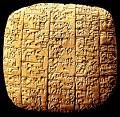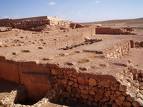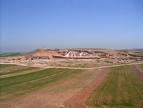Ebla (Arabic: عبيل، إيبلا ) was an ancient city located in northern Syria, about 55 km southwest of Aleppo. It was an important city-state in two periods, first in the late third millennium BC, then again between 1800 and 1650 BC.
The site is known today as Tell Mardikh, and is famous mainly for archives of about 15,000 cuneiform tablets, dated from around 2250 BC, in Sumerian and in Eblaite — a previously unknown Semitic language.
 The name "Ebla" means "White Rock", and refers to the limestone outcrop on which the city was built. Although the site shows signs of continuous occupation since before 3000 BC, its power grew and reached its apogee in the second half of the following millennium. Ebla's first apogee was between 2400 and 2240 BC; its name is mentioned in texts from Akkad around 2300 BC.
The name "Ebla" means "White Rock", and refers to the limestone outcrop on which the city was built. Although the site shows signs of continuous occupation since before 3000 BC, its power grew and reached its apogee in the second half of the following millennium. Ebla's first apogee was between 2400 and 2240 BC; its name is mentioned in texts from Akkad around 2300 BC.
Most of the Ebla palace tablets, which date from that period, are about economic matters; they provide a good look into the everyday life of the inhabitants, as well as many important insights into the cultural, economic, and political life of northern Syria and Near East around the middle of the third millennium B.C. The texts are accounts of the state revenues, but they also include royal letters, Sumerian-Eblaite dictionaries, school texts and diplomatic documents, like treaties between Ebla and other towns of the region.
 Ebla's most powerful king was listed as Ebrium, or Ibrium, who concluded the so-called "Treaty with Ashur", which offered the Assyrian king Tudia the use of trading post officially controlled by Ebla.
Ebla's most powerful king was listed as Ebrium, or Ibrium, who concluded the so-called "Treaty with Ashur", which offered the Assyrian king Tudia the use of trading post officially controlled by Ebla.
The fifth and last king of Ebla during this period was Ebrium's son, Ibbi-Sipish, the first to succeed in a dynastic line, thus breaking with the established Eblaite custom of electing its ruler for a fixed term of office, lasting seven years.
This absolutism may have contributed to the unrest that was ultimately instrumental in the city's decline. Meantime, however, the reign of Ibbi-Sipish was considered a time of inordinate prosperity, in part because the king was given to frequent travel abroad. It was recorded both in Ebla and Aleppo that he concluded specific treaties with neighboring Armi, as Aleppo was called at the time.
Some well-known Semitic deities appear at Ebla (Dagan, Ishtar, Resheph, Kanish, Hadad), and some otherwise unknown ones (Kura, Nidakul), plus a few Sumerian gods (Enki and Ninki) and Hurrian gods (Ashtapi, Hebat, Ishara).
Among Pettinato's controversial claims, he has also suggested that there was a change in the theophoric names shown in many of the tablets found in the archive from *El to *Yah, indicated in the example of the transition from Mika’el to Mikaya. This is considered by some to evidence an early use of the divine name Yah, a god who they believe later emerged as Yahweh (YHWH). Bottero, for example, has suggested that this shift may indicate the popular acceptance of the Akkadian God Ea, introduced from the Sargonid Empire which may have been transliterated into Eblaite as YH. This theory has not gained universal acceptance, however, and other scholars have insisted the sign in question is correctly transliterated IA.
 Many Old Testament Genesis names that have not been found in other Near Eastern languages do have similar forms in Eblaite (a-da-mu / Adam, h’à-wa / Eve, Jabal, Abarama/Abraham, Bilhah, Ishma-el, Isûra-el, Esau, Mika-el, Mikaya, Saul, David, etc.). Also found are many Biblical locations: for example Ashtaroth, Sinai, Jerusalem (Ye-ru-sa-lu-um), Hazor, Lachish, Gezer, Dor, Megiddo, Joppa, etc. Giovanni Pettinato has also claimed to find references to Sodom and Gomorrah.
Many Old Testament Genesis names that have not been found in other Near Eastern languages do have similar forms in Eblaite (a-da-mu / Adam, h’à-wa / Eve, Jabal, Abarama/Abraham, Bilhah, Ishma-el, Isûra-el, Esau, Mika-el, Mikaya, Saul, David, etc.). Also found are many Biblical locations: for example Ashtaroth, Sinai, Jerusalem (Ye-ru-sa-lu-um), Hazor, Lachish, Gezer, Dor, Megiddo, Joppa, etc. Giovanni Pettinato has also claimed to find references to Sodom and Gomorrah.
Three versions of the Eblaite creation hymn have been found. They state
Lord of heaven and earth:
the earth was not, you created it,
the light of day was not, you created it,
the morning light you had not made exist


